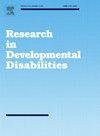Differences in impulsivity between adolescents with ADHD and those with comorbidity of ADHD and IGD
IF 2.9
2区 医学
Q1 EDUCATION, SPECIAL
引用次数: 0
Abstract
Background
Numerous studies have demonstrated that patients with attention deficit hyperactivity disorder (ADHD) have high impulsivity. However, few studies have been published on the differences in impulsivity between patients presenting with comorbidity of ADHD and Internet gaming disorder (IGD) and ADHD alone.
Aim
The present study designed an experiment to address this significant question, to explore the differences in impulsivity between individuals with ADHD and those with comorbid ADHD and IGD, specifically focusing on various dimensions of impulsivity.
Methods
A total of 81 adolescents with ADHD alone and 59 patients with comorbidity of ADHD and IGD were included in this study, and all of them were assessed using the Stop-signal Task (SST), Delay Discount Task (DDT), and Balloon Analogue Risk Task (BART).
Results
Patients with comorbid ADHD and IGD had higher impulsivity than those with only ADHD, and it was expressed in different dimensions. Additionally, response inhibition, delayed discount rate, risky decision-making behavior, inattention, and hyperactivity were identified as risk factors for comorbid ADHD and IGD.
Conclusion
These findings can help distinguish whether ADHD is comorbid with IGD in clinical settings. They will also be helpful in the implementation of more precise treatments.
青少年ADHD与ADHD合并IGD的冲动性差异。
背景:大量研究表明,注意缺陷多动障碍(ADHD)患者具有高度的冲动性。然而,关于ADHD和网络游戏障碍(IGD)共病患者和单独ADHD患者冲动差异的研究很少。目的:本研究设计了一个实验来解决这个重要的问题,探讨ADHD个体和ADHD合并IGD个体在冲动性方面的差异,特别关注冲动性的各个维度。方法:本研究共纳入81例单独ADHD青少年和59例合并ADHD和IGD的患者,采用停止信号任务(SST)、延迟折扣任务(DDT)和气球模拟风险任务(BART)进行评估。结果:ADHD合并IGD患者冲动性高于单纯ADHD患者,且冲动性表现在不同维度。此外,反应抑制、延迟折现率、冒险决策行为、注意力不集中和多动被确定为ADHD和IGD合并症的危险因素。结论:这些发现有助于在临床上区分ADHD是否与IGD合并症。它们也将有助于实施更精确的治疗。
本文章由计算机程序翻译,如有差异,请以英文原文为准。
求助全文
约1分钟内获得全文
求助全文
来源期刊

Research in Developmental Disabilities
Multiple-
CiteScore
5.50
自引率
6.50%
发文量
178
期刊介绍:
Research In Developmental Disabilities is aimed at publishing original research of an interdisciplinary nature that has a direct bearing on the remediation of problems associated with developmental disabilities. Manuscripts will be solicited throughout the world. Articles will be primarily empirical studies, although an occasional position paper or review will be accepted. The aim of the journal will be to publish articles on all aspects of research with the developmentally disabled, with any methodologically sound approach being acceptable.
 求助内容:
求助内容: 应助结果提醒方式:
应助结果提醒方式:


